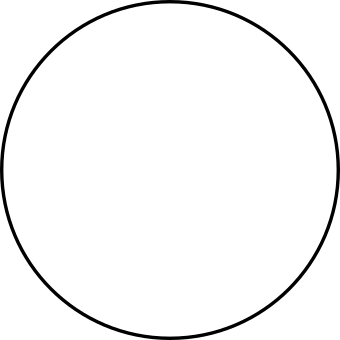Sikatuna, Bohol
Sikatuna, officially the Municipality of Sikatuna (Cebuano: Lungsod sa Sikatuna; Tagalog: Bayan ng Sikatuna), is a 5th class municipality in the province of Bohol, Philippines. According to the 2015 census, it has a population of 6,726 people.[3]
Sikatuna | |
|---|---|
| Municipality of Sikatuna | |
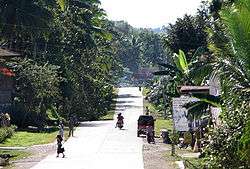 Sikatuna, Bohol | |
 Seal | |
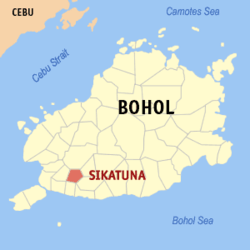 Map of Bohol with Sikatuna highlighted | |
OpenStreetMap 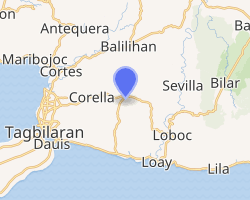
| |
.svg.png) Sikatuna Location within the Philippines | |
| Coordinates: 9°41′N 123°58′E | |
| Country | |
| Region | Central Visayas (Region VII) |
| Province | Bohol |
| District | 1st district of Bohol |
| Founded | 5 December 1917 |
| Named for | Datu Sikatuna |
| Barangays | 10 (see Barangays) |
| Government | |
| • Type | Sangguniang Bayan |
| • Mayor | Justiniana L. Ellorimo |
| • Vice Mayor | Olimpio B. Calimpusan |
| • Congressman | Edgardo M. Chatto |
| • Electorate | 5,123 voters (2019) |
| Area | |
| • Total | 38.22 km2 (14.76 sq mi) |
| Population (2015 census)[3] | |
| • Total | 6,726 |
| • Density | 180/km2 (460/sq mi) |
| • Households | 1,515 |
| Economy | |
| • Income class | 5th municipal income class |
| • Poverty incidence | 19.36% (2015)[4] |
| • Revenue (₱) | 43,672,792.69 (2016) |
| Time zone | UTC+8 (PST) |
| ZIP code | 6338 |
| PSGC | |
| IDD : area code | +63 (0)38 |
| Climate type | tropical monsoon climate |
| Native languages | Boholano dialect Cebuano Tagalog |
Located 17 kilometres (11 mi) from Tagbilaran, it has a total area of 3,822 hectares (9,440 acres), making it the smallest municipality in Bohol. The town is named after Datu Sikatuna, the ancient chieftain of Bohol, although there is no evidence he lived in the area.[5]
The town of Sikatuna,Bohol celebrates its feast on June 12–13, to honor the town patron Saint Anthony De Padua.[6]
History
Sikatuna was formerly a part of the towns of Baclayon and Alburquerque. While part of Baclayon, Sikatuna was known as barrio Cambojod. Once Alburquerque became a town, Sikatuna was made a part of its new territory and given the name Cornago. Sikatuna became its own town in 1917. The ten barangays that now comprise Sikatuna were taken from three neighboring old municipalities: Alburquerque, Loboc, and Balilihan. In the original municipal ordinance converting barrio Cornago into a municipality, the municipal boundary was defined as barrio Cornago plus four northern barrios of Alburquerque: Libjo, Abucay Sur, Abucay Norte, and Can-agong. However, Senator Jose A. Clarin helped increase the territorial boundary by taking two barrios from Loboc: Cambuac Sur and Cambuac Norte; and two barrios from Balilihan: Badiang and Bahay-bahay. Cornago was divided into Poblacion I and Poblacion II.[7]
World War II
During the Japanese occupation of the Philippines, Japanese forces established a garrison at the municipal building and installed a puppet mayor. During this time, Sikatuna became a haven for evacuees, both from neighboring towns and from nearby Cebu. The most famous evacuee was Don Mariano Jesus Cuenco who, after the war, became Senator and later, Secretary of Public Works. In 1945, Sikatuna was entered by Philippine Commonwealth Army soldiers and Boholano guerrillas fought against the Japanese Imperial forces during the Second Battle of Bohol.
Barangays
Sikatuna comprises 10 barangays. Of these, only Poblacion I is classified as urban and the rest are rural.
| PSGC | Barangay | Population | ±% p.a. | Area | PD 2015 | |||||
|---|---|---|---|---|---|---|---|---|---|---|
| 2015[3] | 2010[8] | ha | acre | /km2 | /sq mi | |||||
| 071241001 | Abucay Norte | 7.7% | 516 | 460 | 2.21% | 149 | 368 | 350 | 900 | |
| 071241002 | Abucay Sur | 9.9% | 666 | 582 | 2.60% | 194 | 479 | 340 | 890 | |
| 071241003 | Badiang | 8.9% | 599 | 605 | −0.19% | 409 | 1,011 | 150 | 380 | |
| 071241004 | Bahaybahay | 6.4% | 430 | 396 | 1.58% | 290 | 717 | 150 | 380 | |
| 071241005 | Cambuac Norte | 10.2% | 688 | 632 | 1.63% | 421 | 1,040 | 160 | 420 | |
| 071241006 | Cambuac Sur | 17.5% | 1,174 | 1,173 | 0.02% | 297 | 734 | 400 | 1,000 | |
| 071241007 | Canagong | 9.4% | 635 | 689 | −1.54% | 299 | 739 | 210 | 550 | |
| 071241008 | Libjo | 7.1% | 480 | 466 | 0.57% | 310 | 766 | 150 | 400 | |
| 071241009 | Poblacion I | 17.0% | 1,141 | 1,009 | 2.37% | 202 | 499 | 560 | 1,500 | |
| 071241010 | Poblacion II | 5.9% | 397 | 368 | 1.45% | 251 | 620 | 160 | 410 | |
| Total | 6,726 | 6,380 | 1.01% | 3,822 | 9,444 | 180 | 460 | |||
Climate
| Climate data for Sikatuna, Bohol | |||||||||||||
|---|---|---|---|---|---|---|---|---|---|---|---|---|---|
| Month | Jan | Feb | Mar | Apr | May | Jun | Jul | Aug | Sep | Oct | Nov | Dec | Year |
| Average high °C (°F) | 28 (82) |
28 (82) |
29 (84) |
31 (88) |
31 (88) |
30 (86) |
29 (84) |
29 (84) |
29 (84) |
29 (84) |
28 (82) |
28 (82) |
29 (84) |
| Average low °C (°F) | 22 (72) |
22 (72) |
22 (72) |
23 (73) |
24 (75) |
24 (75) |
24 (75) |
24 (75) |
24 (75) |
23 (73) |
23 (73) |
22 (72) |
23 (74) |
| Average precipitation mm (inches) | 102 (4.0) |
85 (3.3) |
91 (3.6) |
75 (3.0) |
110 (4.3) |
141 (5.6) |
121 (4.8) |
107 (4.2) |
111 (4.4) |
144 (5.7) |
169 (6.7) |
139 (5.5) |
1,395 (55.1) |
| Average rainy days | 18.6 | 14.8 | 16.5 | 16.7 | 23.9 | 26.4 | 25.6 | 24.1 | 24.4 | 26.3 | 23.7 | 20.5 | 261.5 |
| Source: Meteoblue [9] | |||||||||||||
Demographics
| Year | Pop. | ±% p.a. |
|---|---|---|
| 1918 | 4,452 | — |
| 1939 | 4,600 | +0.16% |
| 1948 | 4,713 | +0.27% |
| 1960 | 4,781 | +0.12% |
| 1970 | 4,658 | −0.26% |
| 1975 | 5,169 | +2.11% |
| 1980 | 5,244 | +0.29% |
| 1990 | 5,525 | +0.52% |
| 1995 | 6,030 | +1.65% |
| 2000 | 6,602 | +1.96% |
| 2007 | 6,335 | −0.57% |
| 2010 | 6,380 | +0.26% |
| 2015 | 6,726 | +1.01% |
| Source: Philippine Statistics Authority[3][8][10][11] | ||
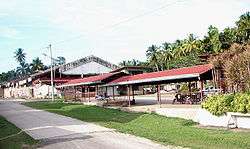
References
- "Municipality". Quezon City, Philippines: Department of the Interior and Local Government. Retrieved 31 May 2013.
- "Province: Bohol". PSGC Interactive. Quezon City, Philippines: Philippine Statistics Authority. Retrieved 12 November 2016.
- Census of Population (2015). "Region VII (Central Visayas)". Total Population by Province, City, Municipality and Barangay. PSA. Retrieved 20 June 2016.
- "PSA releases the 2015 Municipal and City Level Poverty Estimates". Quezon City, Philippines. Retrieved 12 October 2019.
- "Sikatuna Bohol Travel Guide". "www.bohol-philippines.com". Retrieved 2019-05-21.
- "Bohol Festivals Timetable". "www.bohol-philippines.com". Retrieved 2019-03-27.
- "Sikatuna History". "www.bohol-philippines.com". Retrieved 2019-02-22.
- Census of Population and Housing (2010). "Region VII (Central Visayas)". Total Population by Province, City, Municipality and Barangay. NSO. Retrieved 29 June 2016.
- "Sikatuna: Average Temperatures and Rainfall". Meteoblue. Retrieved 9 May 2020.
- Censuses of Population (1903–2007). "Region VII (Central Visayas)". Table 1. Population Enumerated in Various Censuses by Province/Highly Urbanized City: 1903 to 2007. NSO.
- "Province of Bohol". Municipality Population Data. Local Water Utilities Administration Research Division. Retrieved 17 December 2016.
